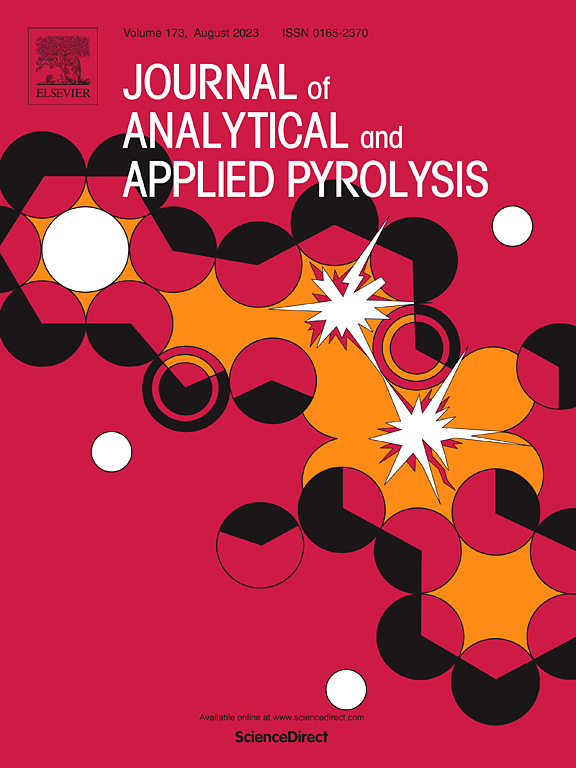不同来源沥青前驱体的分子结构对中间相沥青及其衍生碳纤维结构和性能的影响
IF 6.2
2区 化学
Q1 CHEMISTRY, ANALYTICAL
引用次数: 0
摘要
中间相沥青及其衍生碳纤维的结构和性能与前驱体沥青的分子结构密切相关。在分子水平上探索中间相特性与前体之间的关系具有重要意义。本研究以石油沥青(PP)、煤液化沥青(CLP)和煤焦油沥青(CTP)为原料制备中间相沥青,并系统研究了PP、CLP和CTP的分子结构对中间相沥青及其衍生碳纤维结构和性能的影响。结果表明,聚丙烯具有丰富的脂肪族结构(Hα = 30.79 wt%)和较长的烷基侧链,具有较高的H/C原子比(0.88)和较低的芳构性(fa = 0.64)。半刚性分子结构使MP-PP具有较低的软化点(292℃)、宽域光学织构和优异的可纺性。由于MPCF-PP的平面结构相对较差,微晶结构尺寸较小,有序度较低,导致MPCF-PP的抗拉强度和杨氏模量较低,分别为1258 MPa和146 GPa。CLP具有较高的芳构性(fa=0.70)和大量的环烷结构(HN = 11.02 wt%),以及适量的烷基侧链。芳香分子的有序排列和大尺寸微晶结构的形成(d002 = 0.3423 nm, Lc =4.36 nm)赋予MP-CLP流域光学结构和良好的热稳定性。MPCF-CLP的抗拉强度和杨氏模量最高,分别达到1364 MPa和165 GPa。CTP芳香性最高,烷基侧链最少,PI组分含量最高(20.7 wt%),导致MP-CTP过度缩聚,软化点高(312℃),嵌合结构明显,微晶结构不有序,可纺性最差,导致MPCF-CTP呈分裂形态,力学性能最差。该研究为前驱体沥青的细化、中间相沥青及其衍生碳纤维的制备提供了理论支持。本文章由计算机程序翻译,如有差异,请以英文原文为准。
Influence of the molecular structure of precursor pitch from different sources on the structure and properties of mesophase pitch and its derived carbon fibers
The structure and properties of mesophase pitch and its derived carbon fibers are closely related to the molecular structure of precursor pitch. Exploring the relationship between mesophase characteristics and precursors at the molecular level is of great significance. In this study, mesophase pitch was prepared from petroleum pitch (PP), coal liquefied pitch (CLP), and coal tar pitch (CTP), and the effects of the molecular structures of PP, CLP, and CTP on the structure and properties of mesophase pitch and its derived carbon fibers were systematically investigated. The results showed that PP has the highest H/C atomic ratio of 0.88 and lower aromaticity (fa = 0.64) due to its rich aliphatic structure (Hα = 30.79 wt%) with a long alkyl side chain. The semi-rigid molecular structure endows MP-PP with a low softening point (292 ℃), wide-domain optical texture, and excellent spinnability. The relatively poor planar structure, smaller microcrystalline structure size, and the low order degree of MP-PP result in a lower tensile strength and Young's modulus of MPCF-PP, which were 1258 MPa and 146 GPa, respectively. CLP exhibits higher aromaticity (fa=0.70) and a large number of naphthenic structures (HN = 11.02 wt%), along with a moderate amount of alkyl side chains. The ordered arrangement of aromatic molecules and the formation of large-size microcrystalline structures (d002 = 0.3423 nm, Lc =4.36 nm) give MP-CLP flow-domain optical texture and good thermal stability. MPCF-CLP has the highest tensile strength and Young's modulus among the three types, reaching 1364 MPa and 165 GPa, respectively. CTP had the highest aromaticity, the least amount of alkyl side chain, and the highest PI component content of 20.7 wt%, leading to the excessive condensation of MP-CTP, which has a high softening point (312 ℃), the obvious mosaic structure, the poorly ordered microcrystalline structure, and the worst spinnability, resulting in a splitting morphology of MPCF-CTP and the worst mechanical properties. This study provides theoretical support for the refinement of precursor pitch and the preparation of mesophase pitch and its derived carbon fibers.
求助全文
通过发布文献求助,成功后即可免费获取论文全文。
去求助
来源期刊
CiteScore
9.10
自引率
11.70%
发文量
340
审稿时长
44 days
期刊介绍:
The Journal of Analytical and Applied Pyrolysis (JAAP) is devoted to the publication of papers dealing with innovative applications of pyrolysis processes, the characterization of products related to pyrolysis reactions, and investigations of reaction mechanism. To be considered by JAAP, a manuscript should present significant progress in these topics. The novelty must be satisfactorily argued in the cover letter. A manuscript with a cover letter to the editor not addressing the novelty is likely to be rejected without review.

 求助内容:
求助内容: 应助结果提醒方式:
应助结果提醒方式:


